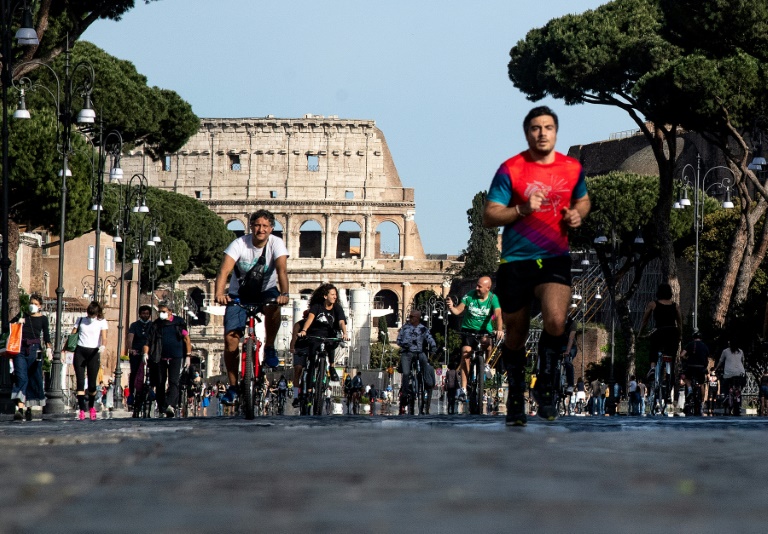
Europe emerges from confinement but Asia infections spike
The mixed fortunes illustrated the high-wire act governments face across the globe as they try to get economies moving while keeping in check a pandemic that has now killed more than 280,000 people.



As Britain plotted a path to normality and France and Spain basked in a relaxation of restrictions, the Chinese city where the pandemic was born reported a second day of new cases after a month without sign of the virus.
And neighbouring South Korea announced its highest number of infections for more than a month driven by a cluster in a Seoul nightlife district.
With millions out of work and economies shattered, governments are desperate to hit the accelerator, but most are choosing a gradual approach as fears about a resurgence of the virus linger.
In Britain Prime Minister Boris Johnson said it was too soon for the country to lift its lockdown but he offered hope by unveiling a “conditional plan” to ease curbs in England during the months ahead.



Johnson said the restrictions had brought “a colossal cost to our way of life” but it would be “madness” to squander the nation’s progress by moving too early.
Almost seven weeks after a nationwide stay-at-home order was put in place, more than 31,800 have died in Britain — a figure second only to the United States.
Elsewhere in Europe, however, officials have been emboldened by declining death rates, with France’s toll dropping to 70 on Sunday, its lowest since early April, and Spain’s daily fatalities falling below 200.
The French were able to walk outside their homes without filling in a permit for the first time in nearly eight weeks on Monday, while teachers began returning to primary schools and some shops were set to re-open.



Many Spaniards meanwhile made plans to meet friends and family at outdoor bars and restaurants, although virus hotspots such as Madrid and Barcelona remain under wraps.
Belgium and Greece were among other European nations set to ease lockdowns on Monday, two months after the World Health Organization declared a pandemic.
As governments across the world chart a course to recovery, Asian nations that were among the first engulfed by the virus but have since brought it to heel are being keenly watched for signs of a second wave.
Much of China has begun to get back to a form of normality, and on Monday Shanghai Disneyland threw open its gates following a three-month shutdown.



“We are very much looking forward to the first day of reopening and wondering what’s the difference inside today compared to before,” said one eager visitor named Kitty.
But enthusiasm in China was tempered by news on Sunday that one person had tested positive for the virus in Wuhan. There were five more cases on Monday.
Local health officials said the new infections were all from the same residential compound in the city and were mostly older people.
South Korean officials ordered nighclubs and bars closed after a fresh burst of transmission linked to a single person who visited five establishments on a night out in early May.



The discovery left authorities scrambling to trace possibly thousands of people who may have come into contact with a 29-year-old who has so far been linked to 85 cases.
But cautious re-opening nevertheless continues around Asia, with one of the world’s largest train networks set to gradually restart operations from Tuesday as India eases its lockdown.
The vast rail system, which usually carries more than 20 million passengers a day, was halted in late March, leaving millions of rural migrant workers unable to return to their homes after losing their jobs in cities.
And success against the virus in Hong Kong has led to a bubbling up of the city’s dormant anti-government protests, with riot police Sunday chasing protesters through shopping malls and streets as democracy activists launched flash mob rallies calling for independence from China.



In the United States, the disease has moved into the White House inner circle, with a spokeswoman for Vice President Mike Pence testing positive. One of Trump’s valets was found to be infected last week.
Nevertheless, Trump’s advisers were out in force on Sunday, appearing on talk shows to push for an end to locally imposed lockdowns.
Small anti-lockdown protests have emerged in a number of US states, with some demonstrators arguing the restrictions violate their rights.
Extended periods at home have also given some people a chance to gather testimony on life in confinement, with the Museum of London launching an appeal for items that reflect the lives of Britons in unprecedented times.



“When we knew there was going to be a lockdown, we started straight away talking about what we needed to collect something for the future,” Beatrice Behlen, the museum’s senior curator, told AFP.
“It could be something that gives you comfort — one example mentioned often is maybe your favourite slippers — you’ve been wearing them every day.”
© AFP | burs-axn/hg

